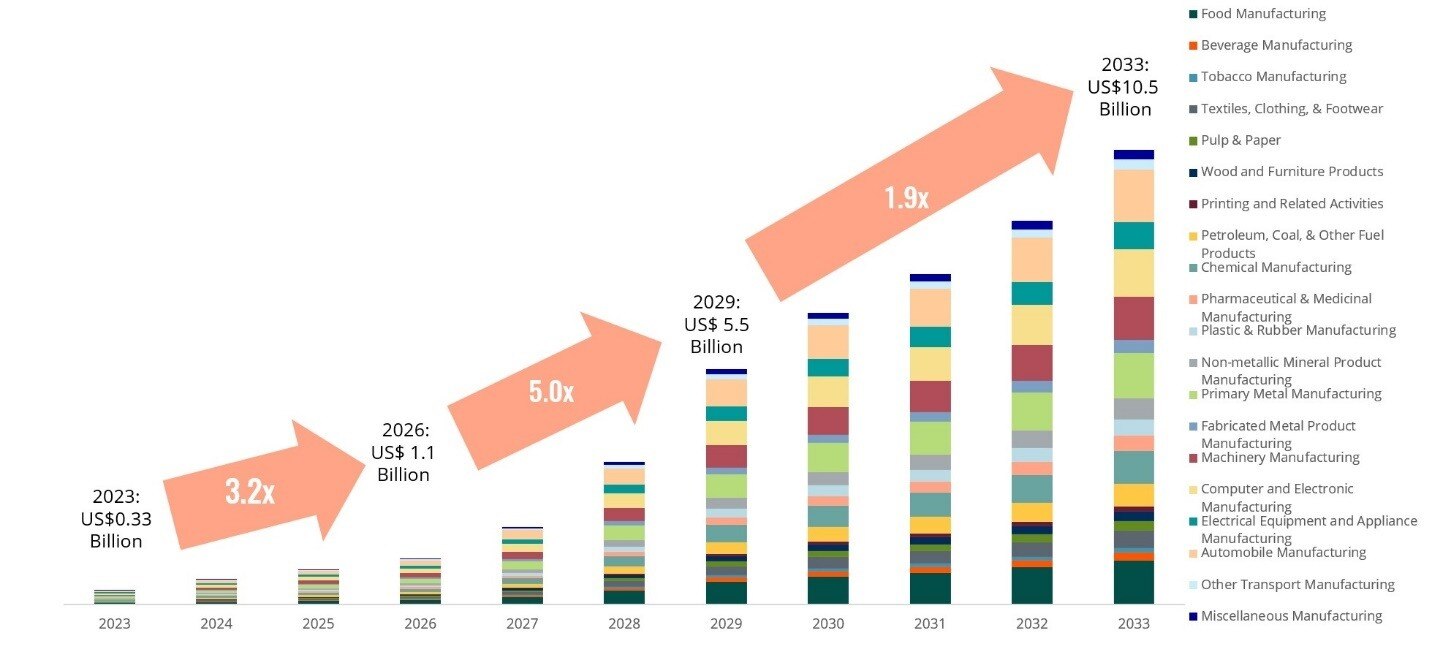Generative Artificial Intelligence (AI) is one of the booming technology topics of our time. ABI Research has multiple research products and articles covering how generative AI will transform the modern enterprise. The manufacturing sector is one industry that gains tremendous benefits from using generative AI. Whether it’s product design or inventory management, there are many use cases for generative AI in manufacturing. In this article, I’ll identify five examples of how generative AI can be applied to the manufacturing industry.
Watch Webinar Replay: Is Generative AI in Manufacturing
A Transformative Technology or Potential Problem?
Chart 1: Generative AI Added Revenue by Manufacturing Vertical

(Source: ABI Research)
What Is Generative AI?
Generative AI is an advanced form of artificial intelligence that produces high-quality content, such as text, music, images, and videos. Generative AI relies on Deep Learning (DL) models that can be trained to perform specific tasks.
Generative AI models are trained on pre-existing content and data. From there, the generative AI software recognizes certain patterns within the content/data to generate original content.
How Manufacturers Can Use Generative AI
ABI Research recently identified 25 ways that generative AI can be applied to manufacturing operations. To sample our findings, here are five ways generative AI is addressing operational challenges in various manufacturing domains.
Table 1: List of Emerging Generative AI Use Cases in Manufacturing
| Use Case | Explanation | Why it Matters |
| Product Quality Assurance | Uses AI to detect defects in real-time. |
|
| Predictive Maintenance Scheduling | AI predicts when machinery needs servicing. |
|
| Inventory Management | Optimizes stock levels and replenishment. |
|
| Sustainability Goals | AI helps meet environmental targets. |
|
| Part Nesting | Generates optimal layouts for parts in manufacturing. |
|
1. Product Quality Assurance
A near-term use case of generative AI in manufacturing is product quality assurance. With more than 6 out of 10 consumers returning products due to poor quality, it’s crucial that manufacturers prevent shipping out goods with defects. Generative AI solves this problem by identifying the root cause of a product defect through historical and current data analysis. In fact, ABI Research's The State of Manufacturing Technology survey found that 78% of manufacturers see Gen being used for faster root cause analysis.
A generative AI platform can pinpoint where defects are occurring in the production line and provide recommendations to correct them. Furthermore, manufacturers can leverage generative AI to accurately predict how many faulty products will be made over a specific time interval.
2. Predictive Maintenance Scheduling
Manufacturers already use AI to monitor factory floor machines' health and operation, but generative AI will improve predictive maintenance capabilities. Generative AI takes various conditional data about a machine and can predict when servicing, machine shutdown, or a backup machine is required.
Generative AI solutions factor in the limitations of individual factory machines for a more accurate evaluation. For example, generative AI knows a machine's maximum workload before experiencing failure. These predictive maintenance applications allow manufacturers to plan machine servicing schedules better, collaborate with buyers, and extend the life span of expensive factory machines.
One notable example of this use case is EOT’s Twin Talk GPT product, a generative AI tool for industrial companies that want to monitor the health of their equipment. Twin Talk GPT combines generative AI and edge computing to simulate events that are expected in an industrial environment. These data are used to train the Machine Learning (ML) algorithms the industrial company relies on for optimizing the condition and performance of equipment. Put simply, EOT’s Twin Talk GPT software offering leverages generative AI to enhance predictive maintenance capabilities.
Learn how Gen AI and Agentic AI can be used in manufacturing by reading our recent article after returning from Hannover Messe 2025.
3. Inventory Management and Purchasing Period Management
Inventory management is a big challenge for manufacturers, especially when economic/geopolitical conditions are volatile, and consumer demand is growing. A recent survey indicates that 68% of supply chain leaders view optimizing inventory levels as a top priority in the next 3 years. Consumer goods manufacturers like Nike are already using generative AI to accurately predict demand for their products.
Generative AI draws insight from various data sources, such as customer behavior, previous sales, industry trends, and seasonal patterns. The technology will also account for warehouse storage capacity and inventory thresholds to generate optimal inventory recommendations.
Another use case for generative AI in inventory management is purchasing period management. By assessing current and anticipated future prices, generative AI informs manufacturers of the best time to buy large quantities of raw materials. Moreover, these solutions ensure that warehouse managers purchase materials on time to avoid potential shortages.
4. Achieve Sustainability Goals
Generative AI can also be used to meet sustainability goals, which 79% of manufacturing and production companies report. Manufacturers can leverage generative AI to optimize the design of a product so that material use and machine use are minimal, thereby reducing their carbon footprint and waste output. Performing a Life Cycle Assessment (LCA) would further enhance results.
Generative AI can be applied to testing software to determine what materials create the most environmentally friendly product design while meeting Key Performance Indicators (KPIs). Due to its additive processes, the automotive industry is currently the biggest benefactor of generative AI for sustainability. For example, General Motors (GM) used Autodesk’s generative AI software to reduce the average weight of 14 vehicle models by 350+ pounds.
5. Part Nesting
Additive manufacturers can use generative AI for part nesting, consolidating multiple components into the same build box for uniform printing. This addresses the challenges of limited work area real estate and slow printing needs.
Generative AI supports part nesting by mapping out and coding a Three-Dimensional (3D) printer in a way that enables individual components of a product to be worked on simultaneously in the machine’s workspace. Generative AI also accelerates production cycle times by accurately calculating the build path to reduce reliance on printed supports.
Conclusion
The use cases of generative AI in manufacturing extend well beyond the five listed in this article. Generative AI is used to improve product design, engineering, production, and operations in various industries. In a recent ABI Research presentation, our analysts identify 20 more ways manufacturers can use generative AI and the timeline for each use case. When will these applications become widespread? How do manufacturers benefit from them? Which industries will experience the largest revenue growth with generative AI adoption? You can get these answers by downloading the report today.
Related Research:
- Development Dictates Siemens’ Current and Future Generative AI Roadmap
- Data Automation Is Driving Discrete Manufacturers toward Enhanced Prescriptive Analytics and Generative AI Deployments
- Generative AI’s Hype Is in Full Swing and Strong Use Cases for Biopharma Manufacturers Have Emerged
- Industrial and Manufacturing Survey 1H 2024: Utilization of Generative AI-Customer Centric

